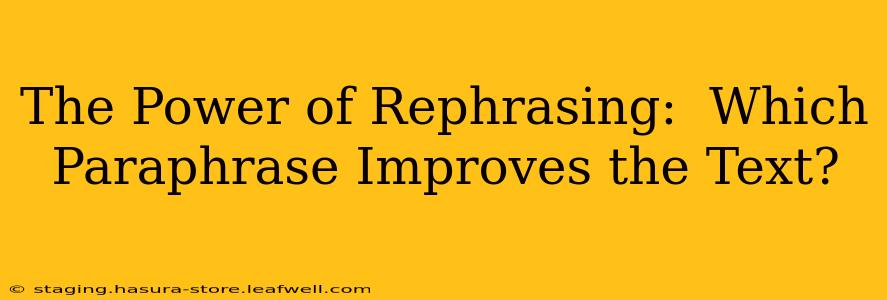The Power of Rephrasing: Which Paraphrase Improves the Text?
Rephrasing, or paraphrasing, is a crucial skill for effective communication and writing. It involves expressing the same information in different words, while maintaining the original meaning. This isn't just about changing a few words; it's about improving clarity, conciseness, and overall impact. Choosing the best paraphrase, however, requires careful consideration. This article explores the nuances of effective paraphrasing and helps you determine which version truly enhances a given text.
What Makes a Good Paraphrase?
A strong paraphrase achieves several key objectives:
- Clarity: It removes ambiguity and makes the meaning readily apparent. Complex sentence structures are simplified, and jargon is replaced with accessible language.
- Conciseness: Unnecessary words and phrases are eliminated, making the writing more efficient and impactful. The core message shines through without unnecessary fluff.
- Accuracy: The meaning of the original text is preserved without distortion or misrepresentation. This is paramount; a good paraphrase doesn't change the core message, just its delivery.
- Originality: It avoids plagiarism by using different vocabulary and sentence structure while retaining the essence of the original. This is critical for academic and professional writing.
Analyzing and Comparing Paraphrases: A Case Study
Let's imagine we have the following original sentence:
"The rapid advancement of technology has resulted in a significant increase in the volume of data generated globally."
Now, consider these three paraphrases:
Paraphrase A: "Technology is moving fast, so we're making lots more data."
Paraphrase B: "The explosion of technological progress has led to a substantial rise in worldwide data generation."
Paraphrase C: "Because technology is developing quickly, there's a lot more data being created around the world."
Which paraphrase is best, and why?
Let's evaluate each based on our criteria:
-
Paraphrase A: While concise, it lacks the formality and precision of the original. Words like "lots more" are informal and vague. It also loses some of the original's academic tone.
-
Paraphrase B: This option maintains a formal tone and accurately reflects the original meaning. Words like "explosion" and "substantial" add a bit more emphasis, while still being appropriate. This paraphrase is a strong contender.
-
Paraphrase C: This paraphrase is grammatically correct and conveys the meaning but lacks the sophistication of Paraphrase B. It is simpler but not necessarily better.
In this case, Paraphrase B is the superior option. It effectively conveys the original meaning while improving the overall impact through more precise and impactful vocabulary. It retains the formal tone suitable for academic or professional contexts.
How to Choose the Best Paraphrase
Here's a step-by-step process:
- Understand the Original: Fully grasp the meaning and intent of the text before attempting to rephrase it.
- Identify Key Concepts: Pinpoint the central ideas and supporting details.
- Rephrase Strategically: Replace words and phrases with synonyms, restructure sentences, and adjust the tone as needed.
- Compare and Contrast: Evaluate different paraphrases against the criteria outlined above (clarity, conciseness, accuracy, originality).
- Seek Feedback: If possible, get a fresh perspective on your paraphrases to ensure clarity and accuracy.
Frequently Asked Questions (FAQs)
Q: Is it always necessary to rephrase information?
A: Not necessarily. If the original text is already clear, concise, and accurate, rephrasing might not be needed. However, rephrasing is valuable when clarity needs improvement, when you need to adapt the tone, or when avoiding plagiarism is essential.
Q: How can I avoid plagiarism when paraphrasing?
A: Always cite the original source. Ensure you are not just replacing words but understanding and restructuring the information to reflect your own understanding. Using paraphrasing tools can help, but always double-check for accuracy and originality.
Q: What are some common mistakes to avoid when paraphrasing?
A: Common mistakes include changing the meaning, using too many of the original words, and failing to cite the source properly. Carefully compare your paraphrase to the original to ensure accuracy.
Mastering the art of effective paraphrasing significantly enhances your writing skills. By following these steps and considering the nuances discussed above, you can consistently choose paraphrases that improve the clarity, impact, and overall quality of your work.

